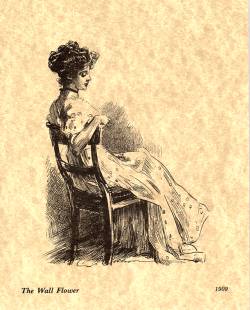Squawk Radio
Tuesday, July 25, 2006
Lisa shows you Gibson's "Wall Flower"

Dear Friends,
A framed copy of this wonderful Charles Dana Gibson print hangs over my desk. For three years I have contemplated this image, which Gibson titled “The Wall Flower” and it has become a personal touchstone and inspiration for my series.
What I love most about Gibson’s “Wall Flower” is that you can read so much into her expression and posture. She isn’t at all defeated or depressed. I see a hint of impatience in the way she sits, and a deliberate attempt to seem casual as she lounges in her solitary chair. I think she knows she’s pretty, and the mystery is why someone so delicious, with her upswept hair and slender neck and frothy dress, would have to wait at all.
This is what I know about the artist, Charles Dana Gibson : he was born in the mid 1800’s, and he was a magazine illustrator. Once he invented the “Gibson girl”, an ideal of womanhood for the 1890’s, he became insanely popular. He was the Elvis of illustration. Gibson girls were willowy, tall, athletic, dreamy, charming, vivacious, utterly romantic . . . they represented what young American women were, and what they aspired to be. And Gibson’s renderings were everywhere, on dishes, tea towels, advertisements, products of every kind. You couldn’t go anywhere without seeing a Gibson girl.
After the turn of the century, Gibson’s elegant young woman was replaced by an equally delightful creature--the flapper. But I still take pleasure in Gibson’s lovely illustrations, and I wonder why turn of the century romance novels have never caught on. I would love to read and research the fascinating period of the 1890s. Some people say it’s not appealing because of its proximity to the two World Wars. Others say a romance novel doesn’t work when it’s set in a time of exploding technology--in short, a hero is more dashing riding a horse than driving a Model T.
When I started writing early Victorian novels a few years ago, a lot of people warned the time period wasn't sexy enough, with all the corsets and voluminous skirts and starched manners. But that was precisely what fascinated me--the contrast between outward propriety and all the human urges that simmered beneath the surface.
What you you think about alternative time periods for romance novels? Do you like the comfort and familiarity of the Regency and Victorian periods to the exclusion of all other settings? Can American be an appealing backdrop for a historical romance too? If you could read a romance set in any place or time, what would you would wish for?
Lisa Kleypas, 4:30 AM
45 comments